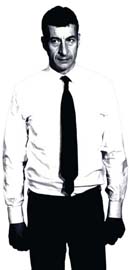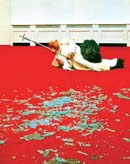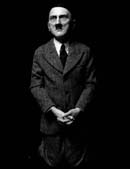Maurizio Cattelan’s playful heresies are pigeonholed in the controversy between essence and appearance that rules different contemporary disguising strategies. Among the body, the object and the action, his hyperrealist sculptures and performances are rendered in this universal endeavor for hiding the true human intentions. Cattelan doesn’t sell himself as a conceptual artist though many of his gestures boast a remarkable density of ideas. He doesn’t either brag about his poetic graveness; however, behind the slightness of certain fables underlies the conversion of the funny to the tragic, the obviously daily life to attractive illusionism leaving very little room for a definition of simple humorist or conceptual jongleur.
“The man’s own genius is the genius of deceit”
Friedrich Nietzsche (Aurora)
Walking the high rope tightened by the banal and the profound, this Italian artist based in New York likes to fall back on the idea that “everything can be anything,” where the biggest challenge implies a convincingly ambiguous condition. By relying on this media haze that can’t be read, his fame is owed more to a frivolous appearance of the discursive skin rather than to the critical dismantling of a misleading distortion of the real thing.
All this glossary of misunderstandings helps configure the contradictory reception of those who usually rely on the mass media to use the spectacular as a means rather than an end. Thus, the scandal unleashed by the artwork reveals itself as the cynical mask that steals the thunder from the genuine face of the drama. None of Cattelan’s pieces illustrates this assertion any better than the three life-size boy dummies he hanged from Milan’s oldest tree. Despite the evidence that those were dummies, the press rushed to make clear that “the children were strung, not hanged.” However, that didn’t stop a neighbor from hacking the installation off to pieces and winding up in the hospital with a brain commotion.
It’s true this anecdote is sprinkled with a novelistic touch and that wagging tongues –they are seldom wrong– rumored that had been a ruse planned by the artist and his sponsor, Massimiliano Gioni, chief of the Nicola Trussardi Foundation. Would that be true, citizen Franco Di Benedetto could rank as the most bigoted or insane of the “actionists on assignment” willing to put his life at risk just to legitimize a manipulation, probably as underpaid as the serial punishments of notorious globetrotter Santiago Sierra.
Being one of the strongest-content pieces in terms of images, and vulnerable in terms of idea, the Milan intervention rekindled the issue of censorship, giving it an alarming validity. Thanks to the longevity of an aberration so repudiated for the grand openings and so necessary for the postponed closings, Cattelan’s hanged children” became an overnight sensation worldwide.
A version of the controversial “public execution” was made during the First Seville Biennial (2004). It then boiled down to a child dangling from a mast in the middle of the street. Once again the controversy set in as local authorities demanded it had to be removed immediately. This situation forced Biennial Commissioner Juana de Aizpuru to take on the role of political activist as she refused to bring down the sculpture. As a minimal gesture was once again making headlines, Cattelan wondered: “How in the world can society be so hypocritical that it gets amazed by a hanged wooden doll when we see ghostly images everyday of children dying or being the victims of wars and other situations?”
Simulating an amazement that suited to a T, Cattelan feigned a common place in the contemporary demagogy: raise the flag of violence that, for the sake of a strategic purpose, had to “wave” in the space under protest. As it happened in the old Milan tree, the author of the provocation feeds himself on what he blasts, taking an ethical stance in the face of that modern backwardness that gives him the image of a troublesome artist branded by absurd social ineptitudes. Before rubbing salt on the wound of social bias, M.C.’s proposal traces the game of media policymaking designed to seduce the millions of passive consumers that roam the planet.
Just another way of exploiting childish system of symbols was put a Hitler head on the shoulders of a 12-year-old punished boy. Cattelan’s satirical flair was back once again, this time around recreating a lampooned version of history’s totalitarian legacy. By ruling out the interactive formula in a bid to generate a “public disturbance”, the artist just appealed to the sculptural object to caricature the fuehrer down on his knees before posterity. Inside the walls of a gallery or museum, this piece didn’t need any headlines to deeply touch the spectator’s critical consciousness. As a matter of fact, his jaunty intuition succumbs to the reason of illustrating how doubtful the immortality of those who persist in making millions of mortals bow at the price of many lives could actually be.
This silent counter-figure of the “small great dictator” transformed into a wax anti-monument (even wearing a three-piece suit) inspires both laughs and pity. Fortunately, this melodramatic sensation embraces the artwork’s nitty-gritty suggestion: today’s executioners will be the knocked-down statues of the future. And not all of them will end up on display as sculptural relics in prestigious museums where the glamour can be skewed into forgiveness.
Cattelan’s subversions focus heavily on bringing down the absurdness of disciplinary abstractions represented as hierarchies that guarantee the safety and security of the citizenship. A good case in point is the “Frank & Jamie” piece (2000), a couple of latex cops with their heads against the wall of the exhibition hall. As it can be clearly noticed, we’re in the presence of a questioning of archetype-symbolic nature willing to turn everything upside down beyond belief. There’s so much those police officers could say or leave unsaid from the quietness of their false museography. Far beyond the concept that engulfs the piece, the most striking element is the image coming from that theatrical hyperrealism shrouded by the artist’s poetic hallmark.
The road Cattelan has traveled on as a prankster is littered with jokes that can be either construed as implacable criticism of the current sociopolitical establishment or as practical jokes played on a couple of bored cops capable of making stunts worth a standing ovation. Sliding along that ambiguous fold between the vast and the trivial, the hieratic and the circus, many of his sculptural gestures set roots to come out as images or get lost as ideas.
To clear those doubts as to the clarity of his demystifying intention, Cattelan plays the unbiased game of insignificance. Thus, he performs the suicide of a squirrel or just puts his own grandmother inside a cold store. And this leads to just another useful countersense in the making of a character: a considerable chunk of the fame M.C. enjoys in the realm of contemporary arts is owed to the premise of paying no respect the public or private canons whatsoever, no even to the family as a sacred institution.
Striking people’s attention at the right time is one of the resorts this photogenic artist –born in Padua in 1960– activates. During the 49th edition of the Venice Biennial (2001), one of his frolicking heresies caused a pretty good impression: “La Nona Hora” showed Pope John Paul II (1920-2005) knocked down by a meteorite over a red carpet littered with broken glass. Something similar came out as he conceived an elephant wearing a KKK mask. These artworks, characterized by a touch of ingenuity, seem to be laid out from the perspective of a shrewd reporter eager to make his showbiz column shine. However, the irritation they caused while being exposed cannot be stacked up against the recognition they grabbed as festive contempt capable of eventually persuading believers and sectarians alike. This bore out that this type of attitude seek silence, and with the help of time, the support of detractors and the adoration of the accomplices.
The interest in melting high and low cultures together from an anti-utopian perspective also characterizes the repertoire of this visual creativeness. During his individual exhibition at MOMA, Cattelan pulled off a prank that went down in the books for its freshness among art-loving spectators. It all came down to asking a friend to put on a huge mask of Pablo Picasso to usher visitors in at the exposition and, of course, sign autographs. As the artist owned up later on, before the Picasso mask he had toyed with the possibility of using the Marcel Duchamp image, but something way deep down inside told him nobody would recognize the author of “The Great Glass.” In spite of the substitution, can we actually say the painter of “Guernica” was recognized by all those who ran into this humongous caricature past the museum’s turnstiles?
Such a doubt is irrelevant compared to the acclaimed shrewdness of taking on such a bizarre esthetic option from the funny side of the action. But behind the apparently tender sarcasm played on the father of cubism, he actually found shelter in the exhibition’s conflicting passage because the head curator turned down Cattelan’s idea of standing at the entrance of the museum like a beggar asking for alms. This incident paved the way for the completion of the public show through an incomprehension negotiated in the offices of the well-known New York institution. Sheer strategic sham: a failed action encouraging a media-hyped buzz.
Like many of his famous colleagues, Cattelan doesn’t rule out the trick of truculence to stay on top of the discussions. Nevertheless, he’s never gone to the extreme of crucifying himself in a car, on drugs, like a strident Chris Burden did; or eating pieces of dead children before TV cameras, like a Chinese artist whose name we don’t want to remember once did. In this sense, his “macabre detours” tend to engage the publicity nomenclature that oozes out of the art system itself. This serves to justify the day he disguised a renowned gallery owner as a pink penis in his own locale, or that another proprietor spent a whole day with his body strapped to the wall.
Paradoxically, a truculence teeming with faked dramatics rank among the most gripping pieces of all. It consisted in leaving a latex hobo sprawled over the street just to make sure nobody would pay any attention to “him.” Rather than encouraging the aggression or derision of the spectators, the provocation was conceptually articulated thanks to the rejection of its reading. Collective apathy toward “somebody else’s suffering” was more than enough to give that intervention a simple and mind-blowing connotation, good enough to avoid falling prey of the naivety of a tabloid reporter poorly untrained in the traps contemporary artists set up. Such a pitiful and brainy truculence underscores conceptual artist John Baldessari’s premise: “The interesting thing about insults is when people don’t realize they really are.”
As some people mistakenly assume, Maurizio Cattelan is far from being the demon of the contemporary art. Better yet, he’s impersonating the lynx of timely moves. By flirting with everything without compromising with anything at all, he’s adding his name to the list of privileged mainstream artists who can both create and sell their crazy stuff without having to renounce to their ideal-thematic obsessions. Deploying a replica of the Hollywood sign in Sicily’s largest garbage dump is not good enough for a pop-minimalist gesture to acquire a political connotation. In that case, irony derives in one more product, something that can be consumed as if it were a giant Coca Cola soda on behalf on a strictly symbolic urban surrealism.
Nobody like M.C. himself to say with pleasure: “If I knew what art is good for, I’ll be a collector.” Following this statement made to the Flash Art magazine’s chat channel, any lengthy explanation on the heaviness or lightness of his work is rendered worthless. By discarding himself as an individual who aspires to achieve human redemption through the arts, Cattelan personifies an advertising boomerang not interested at all in being absolved by history or by anyone. His statement could perfectly be: “Soft on the nerds and hard on the smarts.”
Some observers labeled as prophet wannabes who make the rounds in the international circuit consider Maurizio Cattelan the Duchamp of the 21st century. But as the mastermind of the contemporary visual revolution warned, “Posterity is a prostitute who cheats on some, makes it up for other (like El Greco) and keeps for herself the right to change her mind every fifty years.” There’s no need to overdo it. It0ll be a whole lot better to share Gabriel Orozco’s opinion, who considers Cattelan the most important artist of his generation.




Related Publications

How Harumi Yamaguchi invented the modern woman in Japan
March 16, 2022
Giovanni Duarte and an orchestra capable of everything
August 26, 2020











